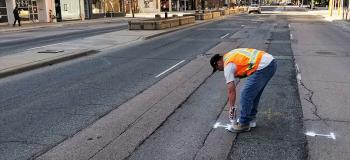When utility companies, and others, make cuts into the pavement for utility installation or maintenance, the cuts and subsequent repairs/patching can reduce the structural integrity of the street and cause the pavement to deteriorate more quickly. The result is poorer pavement performance and higher costs to taxpayers. The lack of an adequate utility cut management program can be costly.

Applied Research Associates, Inc. (ARA) offers services to help cities reduce that burden, and we recently supported the City of Toronto in their effort to more effectively manage the City’s utility cuts.
Each year, Toronto issues permits for some 50,000 utility cuts. Once a permit is issued and underground work completed, the Utility completes a temporary restoration. The Utility is required to monitor and repair deficiencies for up to 18 months. Permanent repairs are then carried out by the City, which then recovers the cost of the repairs, plus overhead expenses and a pavement degradation fee, from the Utility. In administering this process, the City found that the staffing required to keep up with the backlog of permits and the inspection work orders was exceeding capacity.
“Utility cuts pose a perpetual problem in terms of maintaining pavement quality on complex roadway networks such as in the City of Toronto,” said Lori Schaus, an ARA civil engineer. “An immense backlog of unverified utility cut permits and unrestored pavement is not unique to the City of Toronto and is quite common for many major metropolitan areas. Lack of an effective utility cut management program can cost cities millions of dollars in uncollected permit and pavement degradation fees, increased maintenance or rehabilitation costs, reduced pavement life, and more.”
ARA has helped alleviate the backlog for the City of Toronto using state-of-the-art technologies related to mobile mapping, cloud computing, and web dashboard reporting to remove as much operating complexity as possible for field inspectors tasked with identifying permit locations in need of permanent repairs.
“ULTIMATELY, THIS ARA-DEVELOPED PROCESS ENABLED EFFECTIVE AND TIMELY DATA COLLECTION AND DELIVERY, WITH ALL DATA TIED TO THE CITY’S STREET SEGMENTS AND WARDS, AS WELL OTHER CRITICAL ATTRIBUTES.” – ARA SENIOR CIVIL ENGINEER LORI SCHAUS
ARA assisted the City with verifying the backlog status of about 19,000 permit locations dating back to 2008, confirming whether a permanent repair was completed, and making recommendations for further action, if needed. For permit locations requiring permanent repairs, inspections included an estimate of the type and amount of work needed to repair the street in accordance with the permit regulations. In addition, ARA helped develop a two-year work program to eliminate the backlog of repairs.
These services could be beneficial to other major metropolitan areas that are either dealing with utility cut backlogs like Toronto or trying to prevent such backlogs.
“We believe that our innovative solution could be very beneficial for many other major metropolitan areas,” Schaus said. “Our methodology could be used to assist a city with implementing a utility cut management program, training staff, and preventing and/or mitigating large backlogs of utility cut inspections.”



